日本食品添加物使用标准列表(2009年3月2日更新)
- 格式:pdf
- 大小:591.20 KB
- 文档页数:24

2011年第卷第期1410饮料工业日本发布了最新食品添加剂使用标准(2011年9月1日起生效)和指定食品添加剂名单(2011年9月5日起生效)。
日本的食品添加剂可分为“指定的食品添加剂”、“现存的食品添加剂”、“天然调味剂原料”和“通常作为食品也可作为食品添加剂的物质”。
(1)指定的食品添加剂1947年,日本食品卫生法对添加剂实施主动列表制度,即只允许在食品中使用日本厚生省指定的认为安全的食品添加剂。
在1995年之前,主动列表系统仅适用于化学合成的添加剂。
在1995年,日本对食品卫生法进行修订,使该系统涵盖除个别豁免外的所有合成及非合成添加剂。
指定的食品添加剂可分为有使用标准的食品添加剂及无使用标准的食品添加剂两类。
不受主动列表系统约束的食品添加剂包括以下几类:(2)现存的食品添加剂1995年法规修订之前,已经在市场上销售或使用的不受主动列表系统约束的食品添加剂,均为非化学合成添加剂。
1996年4月16日,日本后生省公布了现存食品添加剂清单。
(3)天然调味剂原料,不受主动列表系统约束;(4)通常作为食品也可作为食品添加剂的物质。
(食品产业网2011-09-16)日本发布最新食品添加剂使用标准Analysis and research on product structure adjustment of and green technology application in plasticsmachinery in “12th Five-Year Plan ”(Ⅴ)ZHANG You-gen(Ningbo Haida Plastics Machinery Co.,Ltd.,Ningbo 315200,Zhejiang ,China)Abstract :The application and development of green technology is the core of product structure adjustment of plastics machinery in “the 12th Five-year Plan ”.Green technology works mainly in the improvement of utilization efficiency of energy and otherresources ,the reduction of molding cost ,the abatement of environmental pollution ,the enhancement of cleanliness ,etc.Meddle-and low-end plastics machinery is not optimistic at present in China.The middle-and low-end markets will be the first to be affected if the plastics machinery market declines ,resulting in the biggest shock on domestic manufacturers ;high-end plastics machinery has a broad development space for satisfying the needs of scientific and technological progresses of the related industries.High-end plastics machinery is equipment fully reflecting the essence of green technology.Several issues were focused upon which need to be solved in the product structure adjustment of and green technology application in 4major categories of plastics machinery ,including injection -molding equipment ,stretching -blowing -molding equipment ,extruding equipment and insulating equipment.It will be the only way of changing the status of middle -and low -end plastics machinery and creating Chinese-made green technology to discard old concepts of development ,focus on innovation technology and development ideas ,accelerate the independent development of plastics machinery with scientific innovations ,launch high-end plastics machinery ,and master green core technology.Key words :plastics machinery ;product structure adjustment ;green technology ;independent innovation ;analysis and research CLC No.:TQ320.5Document code :Bdoi :10.3969/j.issn.1007-7871.2011.10.011机械、装备与设计50。
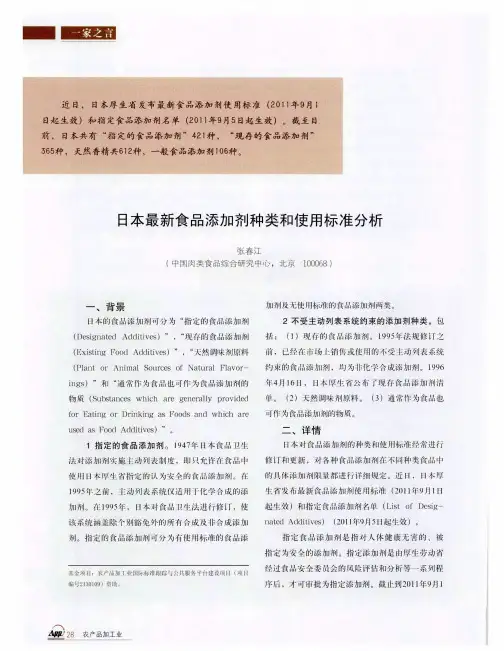
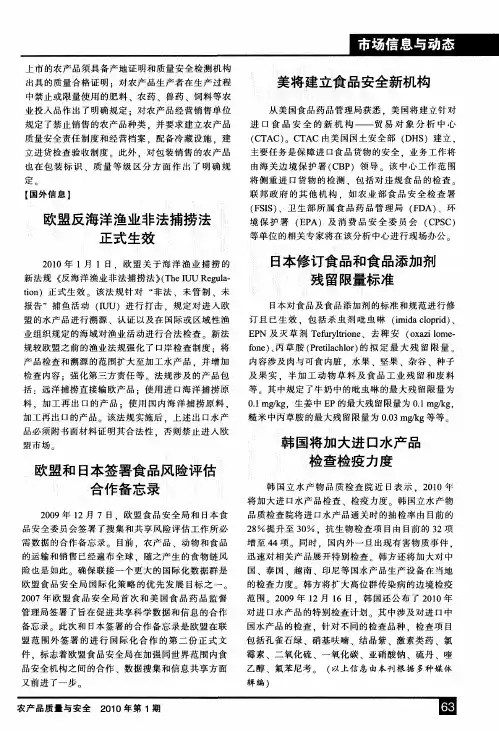
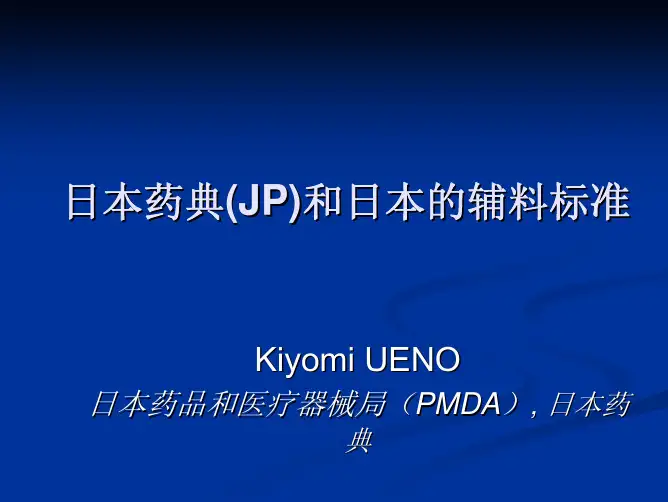
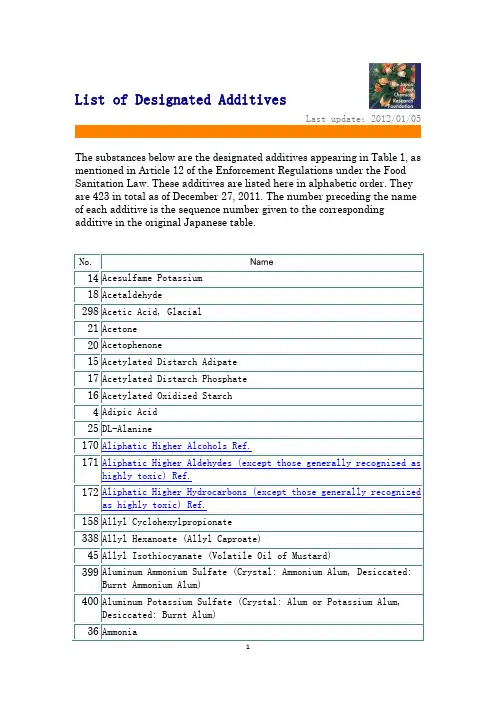
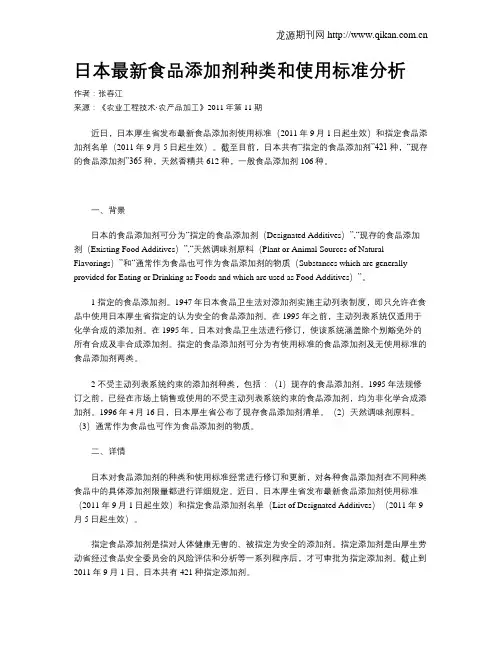
日本最新食品添加剂种类和使用标准分析作者:张春江来源:《农业工程技术·农产品加工》2011年第11期近日,日本厚生省发布最新食品添加剂使用标准(2011年9月1日起生效)和指定食品添加剂名单(2011年9月5日起生效)。
截至目前,日本共有“指定的食品添加剂”421种,“现存的食品添加剂”365种,天然香精共612种,一般食品添加剂106种。
一、背景日本的食品添加剂可分为“指定的食品添加剂(Designated Additives)”,“现存的食品添加剂(Existing Food Additives)”,“天然调味剂原料(Plant or Animal Sources of Natural Flavorings)”和“通常作为食品也可作为食品添加剂的物质(Substances which are generally provided for Eating or Drinking as Foods and which are used as Food Additives)”。
1 指定的食品添加剂。
1947年日本食品卫生法对添加剂实施主动列表制度,即只允许在食品中使用日本厚生省指定的认为安全的食品添加剂。
在1995年之前,主动列表系统仅适用于化学合成的添加剂。
在1995年,日本对食品卫生法进行修订,使该系统涵盖除个别豁免外的所有合成及非合成添加剂。
指定的食品添加剂可分为有使用标准的食品添加剂及无使用标准的食品添加剂两类。
2 不受主动列表系统约束的添加剂种类,包括:(1)现存的食品添加剂。
1995年法规修订之前,已经在市场上销售或使用的不受主动列表系统约束的食品添加剂,均为非化学合成添加剂。
1996年4月16日,日本厚生省公布了现存食品添加剂清单。
(2)天然调味剂原料。
(3)通常作为食品也可作为食品添加剂的物质。
二、详情日本对食品添加剂的种类和使用标准经常进行修订和更新,对各种食品添加剂在不同种类食品中的具体添加剂限量都进行详细规定。
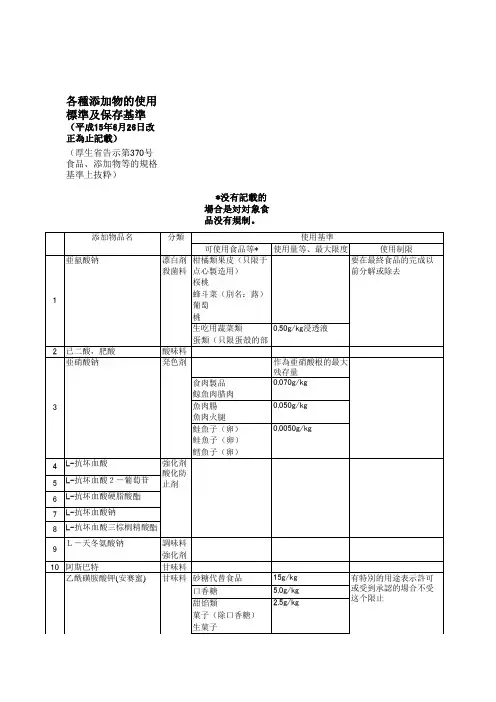
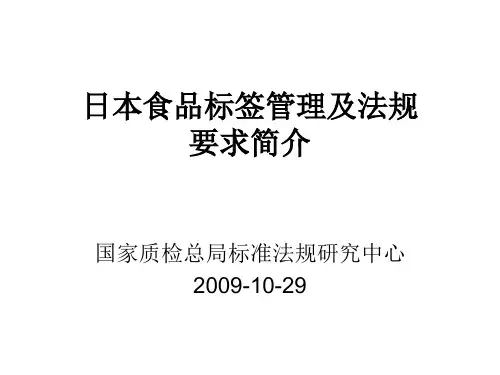
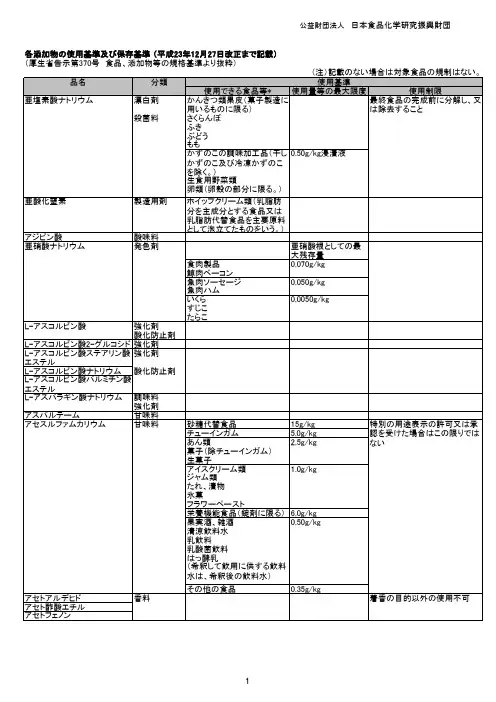
各添加物の使用基準及び保存基準(平成23年12月27日改正まで記載)(厚生省告示第370号 食品、添加物等の規格基準より抜粋)品名分類使用できる食品等*使用量等の最大限度使用制限亜塩素酸ナトリウム漂白剤かんきつ類果皮(菓子製造に用いるものに限る)殺菌料さくらんぼふきぶどうももかずのこの調味加工品(干しかずのこ及び冷凍かずのこを除く。
)生食用野菜類卵類(卵殻の部分に限る。
)亜酸化窒素製造用剤ホイップクリーム類(乳脂肪分を主成分とする食品又は乳脂肪代替食品を主要原料として泡立てたものをいう。
)アジピン酸酸味料亜硝酸ナトリウム亜硝酸根としての最大残存量食肉製品鯨肉ベーコン魚肉ソーセージ魚肉ハムいくらすじこたらこ強化剤酸化防止剤L-アスコルビン酸2-グルコシド強化剤L-アスコルビン酸ステアリン酸エステル強化剤L-アスコルビン酸ナトリウム酸化防止剤L-アスコルビン酸パルミチン酸エステル調味料強化剤アスパルテーム甘味料アセスルファムカリウム砂糖代替食品15g/kg チューインガム 5.0g/kg あん類菓子(除チューインガム)生菓子アイスクリーム類ジャム類たれ、漬物氷菓フラワーペースト栄養機能食品(錠剤に限る) 6.0g/kg 果実酒、雑酒0.50g/kg清涼飲料水乳飲料乳酸菌飲料はっ酵乳(希釈して飲用に供する飲料水は、希釈後の飲料水)その他の食品0.35g/kgアセトアルデヒドアセト酢酸エチルアセトフェノン(注)記載のない場合は対象食品の規制はない。
特別の用途表示の許可又は承認を受けた場合はこの限りではない香料着香の目的以外の使用不可甘味料 2.5g/kg 1.0g/kgL-アスパラギン酸ナトリウムL-アスコルビン酸発色剤0.070g/kg 0.050g/kg 0.0050g/kg使用基準最終食品の完成前に分解し、又は除去すること0.50g/kg浸漬液使用できる食品等*使用量等の最大限度使用制限アセトン製造用剤ガラナ豆油脂ガラナ飲料を製造する際のガラナ豆の成分を抽出する目的及び油脂の成分を分別する目的に限る。
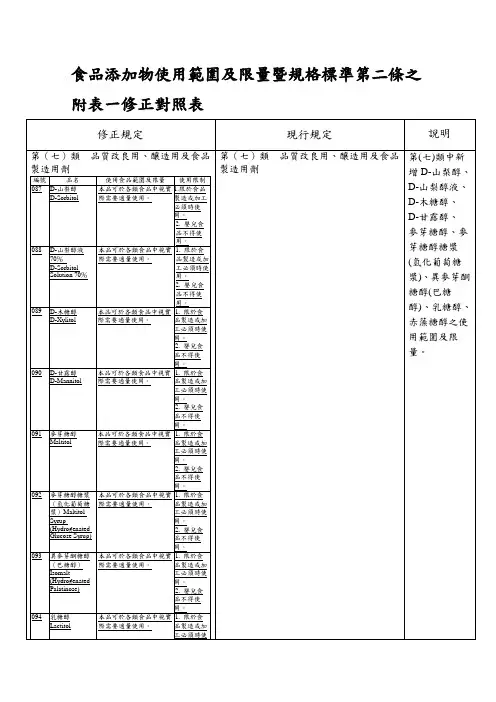
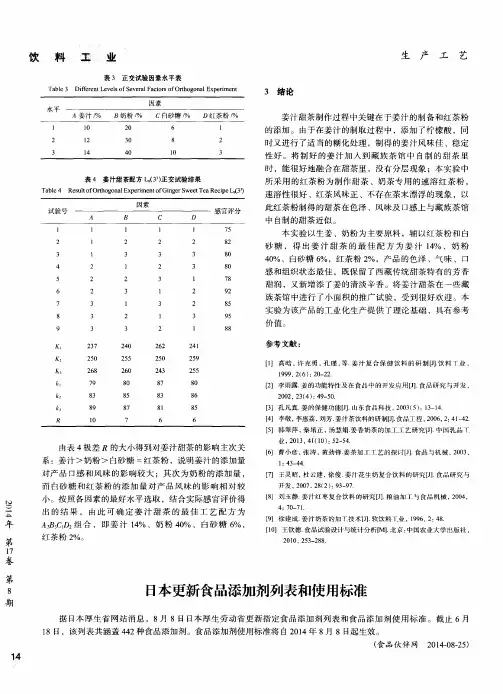
Major Use CategoryAdditivesTarget FoodsMaximum LimitsLimitation for UseppmAcidifiers Acetic Acid All foodsAcetic Acid, Glacial Adipic Acid Citric Acid Fumaric Acid Gluconic Acid Glucono-δ-Lactone Lactic Acid DL-Malic Acid Succinic Acid D-Tartaric Acid DL-Tartaric AcidAnti-cakingFerrocyanides of Calcium,Potassium and SodiumSaltIndividually or in combination,0.020g/kg asanhydrous sodium ferrocyanide Anti-foaming agent Silicone resin All foods0.050 g/kg Only for defoaming.Anti-molding agentsDiphenylGrapefruit 0.070 g/kg Lemon 0.070 g/kg Orange0.070 g/kg ImazalilBanana 0.0020 g/kg Citus fruits0.0050 g/kg(except mandarin orange)o-Phenylphenol Sodium o -Phenylphenol Citrus fruitsThiabendazoleBanana (whole)0.0030 g/kg Banana (pulp)0.0004 g/kg Citrus fruits0.010 g/kgAntioxidantsL-Ascorbic Acid All foods L-Ascorbyl Palmitate L-Ascorbyl StearateButylated Hydroxyanisole (BHA)as BHA Butter 0.2 g/kg Fats & oils0.2 g/kg Fish & shellfish (dried)0.2 g/kg Fish & shellfish (salted)0.2 g/kg Fish & shellfish (frozen)1 g/kg of dip(except frozen products cosumed raw)Mashed potato (dried)0.2 g/kg Whale meat (frozen)1 g/kg of dip(except frozen products cosumed raw) Standards for Use, according to Use Categorieseffective from June 04, 2009When BHA is used incombination with BHT, the total amount of both shall not exceed the corresponding limit.as maximum residue limitas maximum residue limit as maximum residue limit of o -phenylphenol 0.010g /kg as maximum residue limitAntioxidants Butylated Hydroxytoluene as BHA (continued) (BHT)Butter0.2 g/kg Chewing gum 0.75 g/kg Fats & oils0.2 g/kg Fish & shellfish (dried)0.2 g/kg Fish & shellfish (salted)0.2 g/kg Fish & shellfish (frozen) 1 g/kg of dip(except frozen products cosumed raw)Mashed potato (dried)0.2 g/kg Whale meat (frozen)1 g/kg of dipCalcium Disodium as EDTA-CaNa 2 Ethylenediamine-0.035 g/kg tetraacetate0.25 g/kgBread Fruit juiceas EDTA-CaNa 20.035 g/kg Other canned and bottled foods 0.25 g/kgErythrobic AcidAll foodsIsopropyl CitrateButter0.10 g/kg Fats and oils0.10 g/kg Guaiac ResinButter1.0 g/kg Fats and oils 1.0 g/kg Propyl GallateButter 0.10 g/kg Fats and oils0.20 g/kgSodium L-Ascorbate All foods Sodium ErythorbateAll foodsdl -α-Tocopherol All foodsAntisticking D-Mannitol Candies40 %Chewing gum20 %FURIKAKE (sprinkleover only products containing granues)RAKUGAN (dried rice-flour cakes)30 %25 %All foods as CHOMIRYO (seasoning)*When BHA is used incombination with BHT, the total amount of both shall not exceed the corresponding limit.(except frozen products cosumed raw)Canned and bottle non- alcoholic beveragesDisodium Ethylene- diaminetetraacetateCanned and bottle non- alcoholic beveragesOther canned and bottle foods Shall be chelated with calcium ino before the preparation of the finished food.Not permitted for nutritive purposes in fish pasteproducts (excluding SURIMI)or bread.Only for antioxidizing purposes in other foods.as monoisopropyl citrate Not permitted for nutritive purposes in fish pasteproducts (excluding SURIMI)or bread.Only for antioxidizing purposes in other foods.Only for antioxidizing, except when included in preparation of β-Carotene, Vitamin A,Vitamin A Esters of Fatty Acids, or Liquid Paraffin.L-Cysteine Monohydro- chlorideTSUKUDANI (food boiled down in soy sauce, only products made of KONBU (kelp))50 % of granules (as maximum residue limit)* When used in formula with Potassium Chloride andGlutamate for seasoning foods or enhancing their original flavor, no limits are specified. (only cases where D-Mannitol does not exceed 80% of the sum of Potassium Chloride, Glutamates and D-Mannitol)Color fixatives Ferrous Sulfate All foodsPotassium Nitrateless than:Meat products 0.070 g/kg Whale meat bacon0.070 g/kg (as residue limit of NO 2Sodium Nitrate as maximum Sodium Nitriteresidue limit of nitrite Fish ham 0.050 g/kg Fish sausage0.050 g/kg IKURA (salted/processed 0.0050 g/kg salmon roes)Meat products0.070 g/kg SUJIKO (salted salmon roes)0.0050 g/kg TARAKO0.0050 g/kg Whale meat bacon 0.070 g/kg Color adjuvant Ferrous GluconateTable olive0.15 g/kgDietary SupplementsL-Ascorbic acid 2-glucoside All foodsBiotin Foods with health claims Bisbentiamine All foodsCalcium Carbonate*as Ca Calcium Chloride All foods1.0 %Calcium Citrate Chewing gum*10 % *Calcium Dihydrogen Pyrophosphate Calcium Dihydrogen PhosphateCacium GluconateCalcium Glycerophosphate Calcium HydroxideCalcium LactateDietary Supplements Calcium Monohydrogen All foods(continued)PhosphateCalcium Pantothenate Calcium SulfateCholecalciferolAll foodsSame as for Potassium NitrateThe above limits do not apply to foods approved to be labeled as "special. dietary use."Only when indispensable for manufacturing or processing the food, or when used for nutritive purposes.* Only applied to Calcium CarbonateMay also be used as dietary supplement.See the section, "Dietary supplements"Only for nutritive purposes.Only when indispensable for manufacturing or processing the food, or when used for nutritive purposes.Only when indispensable for manufacturing or processing the food, or when used for nutritive purposes.Only when indispensable for manufacturing or processing the food, or when used for nutritive purposes.May be used as fermentation regulator. See the section,"Miscellenous."Dietary Supplements Copper Gluconateas copper(continued)Substitutes for human milk0.60 mg/LFoods with health claims5 mg/recommended daily portion of each foodCupric Sulfateas copper Substitutes for human milk0.60 mg/LDibenzoyl Thiamine All foodsDibenzoyl Thiamine Hydrochloride Dry Formed Vitamin A ErgocalciferolFerric Ammonium Citrate Ferric Chloride Ferric Citrate Ferric Pyrophosphate Ferrous GluconateDried milk for pregnant and lactating women.Substitutes for human milk.Weaning foodsFolic AcidAll foodsL-Histidine Monohydro- chloride Iron Lactate L-Isoleucine L-Lysine L-Aspartate L-Lysine L-GlutamateL-Lysin Monohydrochloride DL-Methionine L-Methionine Methyl Hesperidin Nicotinamide Nicotinic Acid L-Phenylalanine All foodsPyridoxine Hydrochloride RiboflavinRiboflavin 5'-Phosphate SodiumRiboflavin Tetrabutyrate Sodium Ferrous Citrate Sodium Pantothenate Thiamine Dicetylsulfate Thiamine Dilaurylsulfate Thiamine Hydrochloride Thiamine Mononitratewhen formulated into a standard concentration.The limit does not apply to cases where these additives are used in formulated dried milk under approval by the Minister of Health, Labor and Welfare.Not permitted in freshfish/shellfish (including fresh whale meat) or meat.May also be used as color adjuvant.See the section, "Color adjuvant."when formulated into a standard concentration.The limit does not apply to cases where these additives are used in formulated dried milk under approval by the Minister of Health, Labor and Welfare.ppmDietary Supplements Thiamine Naphthalene-All foods(continued) 1, 5-disulfonateThiamine ThiocyanateDL-ThreonineL-Threonineall-rac-α-Tocopheryl Acetate Foods with health claims as α-TocopherolR,R,R-α-Tocopheryl Acetate150mg/recommendeddaily portion of eachfoodTricalcium Phosphate All foods as Ca1.0 %DL-Tryptophan All foodsL-TryptophanL-ValineVitamin AVitamin A Esters ofFatty AcidsVitamin A in OilZinc Gluconate Only substitutes for human milk as zincFoods with health claims15 mg/ recommendeddaily portion of eachfoodZinc Sulfate Only substitutes for human milk as zincEmulsifiers Calcium Strearoyl LactylateBread. 4.0 g/kgButter cakes. 5.5 g/kgConfections(baked or fried wheatflour products only).4.0 g/kgMoist cakes (rice flour products only). 6.0 g/kgMacaroni and other such products.* 4.0 g/kg**as dry noodles.Mixed powder:for manufacturing bread. 5.5 g/kgfor manufacturing confections (friedwheat flour products only).5.5 g/kgfor manufacturing confections(baked wheat flour products only).5.0 g/kgfor manufacturing moist cakes (riceflour products only).10 g/kgfor manufacturing sponge cakes,butter cakes and steamed breads.8.0 g/kgfor manufacturing steamedMANJYU (bun made by steamingwheat flour dough).2.5Noodles(excluding instant noodles and dry noodles)4.5 g/kg**** as boiled noodles.6.0 mg/LWhen formulatedinto a standardconcentration.Not applied to cases where theOnly when indispensable formanufacturing or processingthe food, or when used fornutritive purposes.The above limit donot apply to foodsapproved to belabeled as "special.dietary use."6.0 mg/LWhen formulatedinto a standardconcentration.additives is used in for-mulated dried milk underapproval by the Minister ofHealth, Labor and Welfare.Not applied to cases where theadditives is used in for-mulated dried milk underapproval by the Minister ofHealth, Labor and Welfare.ppm Emulsifiers Calcium Strearoyl Lactylate Sponge cakes.5.5 g/kg (continued)(continued)Steamed bread (bread made by steaming wheat flour dough). 5.5 g/kg Steamed MANJYU2.0 g/kgGlycerol Esters of Fatty All foodsAcids LecithinPolysorbate 20as polysorbate 80Polysorbate 60 Capsule- and tablet-form foods excluding confections 25 g/kg Polysorbate 65 Chewing gum5.0 g/kg Polysorbate 80Cocoa and chocolate products 5.0 g/kg Milk-fat substitutes 5.0 g/kg Sauces5.0 g/kg Seasonings for instant noodles 5.0 g/kg Shortening5.0 g/kg Bakery confections3.0 g/kg Decorations for confections 3.0 g/kg (Sugar coatings and icings) Dressing 3.0 g/kg Ice creams 3.0 g/kg Mayonnaise3.0 g/kg Mix powder for bakery confections and moist sweet cake3.0 g/kg Moist sweet cake, unbaked cake 3.0 g/kg(Including fruit tart, cream cake, rare cheese cake, custard pudding, and like products)Sweetened yoghurt 3.0 g/kg Candies1.0 g/kg Edible ices including sherbet 1.0 g/kg Flour paste* 1.0 g/kg Soup1.0 g/kg Pickled sea weed 0.50 g/kg Pickled vegetables 0.50 g/kg Chocolate drinks 0.50 g/kg Unripened cheese0.080 g/kg Canned and bottled sea weed 0.030 g/kg Canned and bottled vegetables 0.030 g/kg Other foods 0.020 g/kgPropylene Glycol Esters All foodsof Fatty Acids Sorbitan Esters of Fatty AcidsSucrose Esters of Fatty AcidsFilm-forming agentsMorpholine Salts of Fatty Acids Rind of fruits Polyvinyl Acetate*Rind of vegetablesSodium OleateFlavoring agents AcetaldehydeAll foodsOnly for flavoring.AcetophenoneAliphatic Higher Alcohols (excluding substances generally recognized as highly toxic)Aliphatic Higher Aldehydes (excluding substances generally recognized as highly toxic)If it is used together with one of polysorbate 60, 65, and 80,the sum of each amount used shall be not more than the corresponding maximum levels as polysorbate 80. The above standards are not applied for products that are approved or recognized as foods for special dietary use.Flour paste*: In this list, flour paste is confined to paste products of cocoa andchocolate that are prepared with sugar, fat/oil, powder milk,egg, or wheat flour as secondary ingridients, and pasteurized.They are used asfillings or coatings of bread or bakery confections.* Polyvinyl Acetate may also be used as chewing gum base.See the section, "Chewing gum base."Only as film-forming agent.ppmFlavoring agents Alphatic Higher Hydro-All foods Only for flavoring. (continued) carbons (excluding sub-stances generally recog-nized as highly toxic)Ally CyclohexylpropionateAlly HexanoateAlly IsothiocyanateAmylalcoholα-AmylcinnamicaldehydeAnisaldehydeAromatic AlcoholsAromatic Aldehydes(excluding substancesgenerally recognized ashighly toxic)BenzaldehydeBenzyl Acetate.Benzyl AlcoholBenzyl Propionated-BorneolButanolButyl AcetateButyl ButyrateButyraldehydeButyric AcidCinnamic AcidCinnamaldehydeCinnamyl AcetateCinnamyl AlcoholCitralCitronellalCitronellolCitronellyl AcetateCitronellyl FormateCyclohexyl AcetateCyclohexyl ButyrateDecanalDecanol2,3-Dimethylpyrazine2,5-Dimethylpyrazine2,6-DimethylpyrazineEstersEthersppmFlavoring agents Ethyl AcetateAll foods(continued)EthanolYeast extract Vinyl acetate resinEthyl Acetoacetate All foods Only for flavoring.Ethyl Butyrate Ethyl Cinnamate Ethyl Decanoate Mixture of2-Ethyl-3,5-dimethylpyrazine and 2-Ethyl-3,6-dimethylpyrazine Ethyl Heptanoate Ethyl Hexanoate Ethyl Isovalerate 2-Ethyl-3-methylpyrazine Ethyl Octanoate Ethyl Phenylacetate Ethyl Propionate Ethylvanillin 1,8-Cineole Eugenol Fatty AcidsFurfural and its derivatives (excluding substances generally recognized as highly toxic)Geraniol Geranyl Acetate Geranyl Formate Hexanoic Acid Hydroxycitronellal Hydroxycitronellal Di- methylacetalIndole and its derivatives Ionone Isoamyl AcetateOnly for flavoring, execpt when:1. Used for denaturing ethanol which is used for the removal astringency of persimons, the manufacture of crystalline fructose, the preparation of granules or tablets of spices, or the manufacture of KONNYAKU-KO (Konjac powder), or which is used as a solvent for Butylated Hydroxytoluene of ButylatedHydroxyanisole or as an ingredient for the manufacture of vinegar;2. Used for accelerating- yeast-autolysis in the extract (water-soluble fraction obtained by autolysis of yeast;)3. Used as a solvent for vinyl acetate resin.Ethyl Aceteta used in manu-facturing yeast extract shall be removed before the preparation of the finished food.ppmFlavoring agents Isoamylalcohol All foods Only for flavoring. (continued)Isoamyl ButyrateIsoamyl FormateIsoamyl IsovalerateIsoamyl PhenylacetateIsoamyl PropionateIsobutanolIsobutyraldehydeIsobutyl PhenylacetateIsoeugenolIsopropanolIsothiocyanates(excluding substances generallyrecognized as highly toxic)IsovaleraldehydeKetonesLactones(excluding substancesgenerally recognized ashighly toxic)LinaloolLinalyl AcetateMaltoldl-Mentholl-Mentholl-Menthyl AcetateMethyl Athranilate2-MethylbutanolMethyl CinnamateMethyl N-Methylanthra-nilateMethyl β-Naphthyl Ketone5-MethylquinoxalineMethyl Salicylatep-Methylacetophenoneγ-NonalactoneOctanall-PerillaldehydePhenethyl AcetatePhenols(excluding substancesgenerally recognized ashighly toxic)Phenol Ethers(excluding substancesgenerally recognized as highly toxic)PiperonalPropanolPropionic Acid* Terpene Hydrocarbons TerpineolTerpinyl Acetate * Propionic Acid may also be used as preservative. See the section, "Preser-vatives."ppmFlavoring agents 2,3,5,6-Tetramethylpyrazine All foods Only for flavoring.(continued)Thioethers(excluding substances generally recognized as highly toxic)Thiols(excluding substances generally recognized as highly toxic)2,3,5-Trimethylpyrazine γ-Undecalactone Valeraldehyde VanillinFlour treatment agents Ammonium Persulfate Wheat flour 0.30 g/kgBenzoyl PeroxideWheat flourChloride Dioxide Wheat flourDiluted Benzoyl Peroxide Wheat flour0.30 g/kgPotassium BromateBread (only products made of wheat 0.030 g/kg of wheat flour)flourFood Colors Annato, water-solubleβ-CaroteneCopper Chlorophyllas copper 0.0004 g/kgChewing gum 0.050 g/kg Chocolate0.0010 g/kg Fish-paste products 0.030 g/kg (excluding SURIMI)Fruits and vegetables for preserva-0.10 g/kgtion.*KONBU (kelp)0.15 g/kg of dry kelp Copper Chlorophyll Moist cakes (excluding bread with 0.0064 g/kg(continued)sweet fillings or toppings)Can be used only as diluted Benzoyl Peroxide by mixing with one or more of Alum, calcium salts of Phosphoric Acid, Calcium Sulfate, CalciumCarbonate, Magnesium Carbonate, and Starch.Not permitted in fresh fish/shellfish including (fresh whale meat), KONBU (kelp)/WAKAME (sea weed) (both Laminariales ), legumes/pulses, meat NORI (laver), tea,or vegetables.Agar jelly in MITSUMAME (prepared by mixing agar jelly,cut fruits, gree beans, etc. with sugar syrup) packed into cans or plastic containers.* Foods which are processed for preserving, including dried foods, salted foods, pickled foods in vinegar, and preserved foods in syrup.Shall be decomposed or removed before thepreparation of the finished food.Not permitted in fresh fish/shellfish (including whale meat), KONBU(kelp)/WAKAME (sea weed)(both Laminariales ),legumes/pulses, meat, NORI (laver) (except when gold is used on NORI), tea leaves,or vegetables.ppmFood Colors Food Blue No. 1 (Brilliant (continued)Blue FCF) and its Alumi- num LakeFood Blue No. 2 (Indigo Carmine) and its Alumi- num LakeFood Green No. 3 (Fast Green FCF) and its Alu- minum LakeFood Red No. 2 (Amaranth) and its Aluminum Lake Food Red No. 3 (Erythro- sin) and its Aluminum Lake Food Red No. 40 (Allura Red) and its Aluminum LakeFood Red No. 102 (New Coccine)Food Red No. 104 (Phloxine)Food Red No. 105 (Rose Bengale)Food Red No. 106 (Acid Red)Food Yellow No. 4 (Tartra- zine) and its Aluminum LakeFood Yellow No. 5 (Sunset Yellow) and its Aluminum LakeFood colors other than chemically synthesized food additivesIron Sesquioxide Banana (stem only)KONNYAKU (konjac)Preparations of tar colors Same as for Food Blue No. 1.Sodium Copper Chlorophyllin as copper0.0004 g/kgCandies0.020 g/kg Chewing gum 0.050 g/kg Chocolate0.0064 g/kg Fish-paste products (except SURIMI)0.040 g/kg Fruits and vegetables for preserva-0.10 g/kgtion.*KONBU (kelp)0.15 g/kg of dry kelp Sodium Copper Chlorophyllin Moist cakes (excluding bread with 0.0064 g/kg (continued)sweet fillings or toppings)Syrup0.064 g/kgNot permitted in fish pickles,fresh fish/shellfish (including whale meat) KASUTERA (a type of pound cake), KINAKO (roasted soybean flour),KONBU (kelp)/WAKAME (sea weed) (both Laminariales ),legumes/pulses, marmalade,meat, meat pickles, MISO (fermented soybean paste),noodles (including Wantan),NORI(laver), soy sauce,sponge cakes, tea leaves,vegetables, or whale meat pickles.Not permitted in fresh fish/shellfish (including whale meat), KONBU(kelp)/WAKAME (sea weed)(both Laminariales ),legumes/pulses, meat, NORI (laver) (except when gold is used on NORI), tea leaves, or vegetables.Agar jelly in MITSUMAME (pre-pared by mixing agar jelly, cut fruits, gree beans, etc. with sugar syrup) packed into cans or plastic containers.* Foods which areprocessed for preserving,including dried foods, salted foods, pickled foods in vinegar, and preserved foods in syrup.ppmFood Colors Sodium Iron Chlorophyllin(continued)Titanium DioxideHumectant Sodium Chondroitin Sulfate Fish sausage 3.0 g/kgMayonnaise20 g/kgDressing20 g/kgInsecticide Piperonyl Butoxide Cereal grains0.024 g/kgNon-nutritive Sweeteners Acesulfame Potassium An (sweetened bean paste) 2.5 g/kgConfectionary 2.5 g/kgChewing gum 5.0 g/kgEdible ices (including sherbets, 1.0 g/kgflavored ices, and other similarfoods)Fermented milk*0.50 g/kgFlour paste 1.0 g/kg.Ice creams 1.0 g/kgJam 1.0 g/kgFoods with health claims 6.0 g/kg(only tablets)Lactic acid bacterial bevarages* 0.50 g/kgMilk drinks*0.50 g/kgMiscellaneous alcoholic beverages*0.50 g/kgMoist cakes 2.5 g/kgNonalcoholic beverages0.50 g/kgPickles 1.0 g/kgSugar substitutes**15 g/kgTare (a dip or sauce mainly for 1.0 g/kgJapanese or Chinese foods)Wine*0.50 g/kgOther foods 0.35 g/kgAspartameDisodium Glycyrrhizinate MISO (fermented soybean paste)Soy sauceSaccharin Chewing gum0.050 g/kgSodium Saccharin as residue limitof sodium saccharineless than:KOZI-ZUKE (preserved in KOJI, 2.0 g/kgfermented riceSU-ZUKE (vinegar-pickled foods)TAKUAN-ZUKE (rice bran-pickledradishes)Only for coloring.Not permitted in fish pickles, fresh fish/shellfish (including whale meat) KASUTERA (a type of pound cake), KINAKO (roasted soybean flour), KONBU (kelp)/WAKAME (sea weed) (both Laminariales), legumes/pulses, marmalade, meat, meat pickles, MISO (fermented soybean paste), noodles (including Wantan), NORI(laver), soy sauce, sponge cakes, tea leaves, vegetables, or whale meat pickles.** Products used bydirectly adding to drinks, such as coffee and tea.* Applied to dilutions, in the case of concentratedproducts.These maximum limits donot apply to foodsapproved to be labeledas special dietary use. Same as for Annato, water-solubleppm Non-nutritive sweeteners Sodium Saccharin Nonalcoholic beverages (powdered) 1.5 g/kg (continued)(continued)KASU-ZUKE (lee-pickled foods) 1.2 g/kgMISO-ZUKE (MISO-pickled foods)SHOYU-ZUKE (soy sauce-pickledfoods)Fish/shellfish (processed, excludingfish paste, TSUKUDANI (foodsboiled down with soy sauce),pickles, and canned or bottledfoods)Processed sea weeds0.50 g/kgSimmered beansSoy sauceTSUKUDANI (foods boiled down withsoy sauce)Edible ices0.30 g/kgFish pasteLactic acid bacterial drinksMilk drinksNonalcoholic beveragesSaucesSyrupVinegarAn (sweetened bean paste)0.20 g/kgFermented milkFlour pasteIce cream productsJamsMISO (fermented soybean paste)Pickles (preserved or pickled foods,excluding those listed in thiscolumn)Confectionary0.10 g/kgCanned or bottled foods, excluding 0.20 g/kgthose listed above.D-Sorbitol All foodsSucralose Chewing gum 2.6 g/kgConfectionary 1.8 g/kgJam 1.0 g/kgLactic acid becterial beverages*0.40 g/kgMilk drinks*0.40 g/kgMiscellaneous alcoholic bverages*0.40 g/kgMoist cakes 1.8 g/kgNonalcoholic beverages*0.40 g/kgSake*0.40 g/kgSake (compounded)*0.40 g/kg Sugar substitutes**12 g/kg Wine (any kind of fruit wine)*0.40 g/kg Other foods0.58 g/kg** Products used by directly adding to drinks, such as coffee and tea.* Applied to dilutions, in the case of concentratedproducts.These maximum limits do not apply to foods approved to be labeled as special dietary use. These maximum limits donot apply to foodsapproved to be labeledas special dietary use.(less than 1.5 g/kg in case of materials for nonalcoholic beverage or lactic acid bacteria drinks or fermented milk product to be diluted not less than 5-fold before use, less than 0.90 g/kg in case of vinegar to be deluted not less than 3-fold before use)ppmNon-nutritive sweeteners Xylitol All foods(continued)D-XylosePreservatives Benzoic Acid Caviar 2.5 g/kgMargarine 1.0 g/kgNonalcoholic beverages0.60 g/kgSoy sauce0.60 g/kgSyrup0.60 g/kgButyl p-Hydroxybenzoate as p-hydroxybenzoicacidFruit sauce0.20 g/kgnonalcoholic beverages0.10 g/kgRind of fruits and fruit vegetables 0.012 g/kgSoy sauce0.25 g/LSyrup0.10 g/kgVinegar0.10 g/LCalcium Propionate as propionic acidBread and cakes 2.5 g/kgCheese 3.0 g/kgEthyl p-HydroxybenzoateIsobutyl p-HydroxybenzoateIsopropyl p-HydroxybenzoateNisinAs polypeptidecontaining Nisin A Cheese (except processed cheese)0.0125g/kgMeat productsWhipped creamsDressing0.010g/kgMayonnaiseSauces*Fine bakery products0.00625g/kgProcessed cheeseMISO (fermented soybean paste)0.0050g/kgProcessed eggs productsMoist, unbaked, sweet cakes mademaainly of cereal grains or starch**0.0030g/kgPotassium Sorbate as sorbic acid0.30 g/kg When the additive is used in margarine with Sorbic Acid or Potassium Sorbate, or a preparation containing either of these two additives, the total amount of them as benzoic acid and as sorbic acid shall not be more than 1.0 g/kg.When the additive is used in cheese with Sorbic Acid or Potassium Sorbate, or a preparation containing either of these two additives, the total amount of them as propionic acid and as sorbic acid shall not be more than 3.0 g/kg.Same as for Butyl p-Hydroxybenzoate.AMAZAKE (beverages made from fermneted rice using KOJI (Asp. oryzae), and confined toproducts to be coonsumed in 3- fold or more dilution.)Cheese: When used in combination with propionic acid, calcium propionate, or sodium propionate, total level of the additives as sorbic acid and as propionic acid shall not be more than 3.0 g/kg.The maximum use levels are not apply to products permmited or recognized by the Minister of Health, Labour and Welfare as foods for special dietary uses. The foods include five types of products: foods for the ill, milk powder for pregnant and lactating women, formulated milk powder for infants, foods for the aged, foods for specified health uses.* Sauces refer to all kinds of sauces including Oriental thick Worcester sauce, cheese souce, and ketchup, but excluding fruit sauce and its analogues used for cakes.** They refer to rice pudding and tapioca puding, and their analogues, but excluding Oriental sweet dumplings.ppmPreservative Potassium Sorbate AN (sweetened bean paste) 1.0 g/kg(continued)(continued)Candied cherries 1.0 g/kgCheese 3.0 g/kgDried fish/shellfish (excluding 1.0 g/kgsmoking cuttlefish & octopus)Dried prune0.50 g/kgFermented milk (as raw materials for0.30 g/kglactic acid bacterial drinks)Fish-paste products (excluding 2.0 g/kgSURIMI)Flour paste products for bread and 1.0 g/kgconfectionaryFruit juice (including concentrated 1.0 g/kgfruit juice) for confectionaryFruit paste for confectionary 1.0 g/kgGnocchis 1.0 g/kgJams 1.0 g/kgKASU-ZUKE (lees-pickled foods) 1.0 g/kgKetchup0.50 g/kgKOJI-ZUKE (KOJI (Asp. oryzae)- 1.0 g/kgpickled foods)Lactic acid bacterial beverages (ex-0.050 g/kg cluding sterilized bevarages)Lactic acid bacterial beverages (as 0.30 g/kg ingredients of lactic acid bacterialbeverages, excluding sterilizedbeverages)Margarine 1.0 g/kg Meat products 2.0 g/kg Miscellaneous alcoholic beverages 0.20 g/kg MISO (fermented soy bean paste) 1.0 g/kg MISO-ZUKE (MISO-pickled foods) 1.0 g/kg Salted vegetables 1.0 g/kg Sea urchin products 2.0 g/kg SHOYU-ZUKE (soy sauce-pickled 1.0 g/kg foods)Simmered beans 1.0 g/kg Smoked cuttlefish & octopus 1.5 g/kg Soup (excluding potage-type soup)0.50 g/kg SU-ZUKE (vinegar-pickled foods)0.50 g/kg Syrup 1.0 g/kg TAKUAN-ZUKE (rice bran-pickled 1.0 g/kg radish)TARE (a dip or sauce mainly for 0.50 g/kg Japanese or Chinese foods)TSUKUDANI (foods boiled down in 1.0 g/kg soy sauce)TSUYU (a sauce mainly for Japanese0.50 g/kg noodles)Whale meat products 2.0 g/kg Wine (any kind of fruit wine)0.20 g/kg When the additive is used in margarine with Benzoic Acid or Sodium Benzoate, the total amount of them as benzoic acid and as sorbic acid shall not be more than 1.0 g/kg.When the additive is used in MISO-ZUKE, the total amount of Sorbic Acid used in the product, and Sorbic Acid and its salts cntaining in MISO as ingredient shall not be more than 1.0 g/kg.3.0 g/kg.。
财团法人日本健康营养食品协会螺旋藻标准1.适用范围本标准适用于“螺旋藻食品”、“螺旋藻加工食品”、“螺旋藻加工复合食品”,产品形态包括粉末、片剂或颗粒等。
2.定义(1)螺旋藻“螺旋藻”是属于蓝藻类纽子目颤藻科螺旋藻属的藻类,一般为长300~500μm的螺旋状多细胞生物,颜色是绿色或蓝绿色。
(2)螺旋藻粉末螺旋藻粉末是指通过人工培养的螺旋藻以喷雾干燥等方法干燥所得的物质。
(3)螺旋藻食品螺旋藻食品是指螺旋藻粉末以及利用螺旋藻粉末加工的食品,螺旋藻粉末的重量比例应达到95%以上。
(4)螺旋藻加工食品螺旋藻加工食品是指以螺旋藻粉末和其它非螺旋藻食品原料为原料加工的食品,螺旋藻粉末的重量比例应超过50%不足95%。
(5)螺旋藻加工复合食品螺旋藻加工复合食品是指以螺旋藻粉末和其它非螺旋藻食品原料为原料加工的食品,螺旋藻粉末的重量比例应超过30%不足50%。
3.产品规格(1)外观性状外观呈绿色或蓝绿色,无异味异臭。
(2)规格成分含有量①规格成分的含量应该超过下表的数值。
②对产品进行定量分析时,应含有下表中的成分。
(3)①既存脱镁叶绿酸盐(Original pheophorbide)小于50mg%②总脱镁叶绿酸盐(Total pheophorbide)小于100mg%(4)总砷以As计小于2ppm。
(5)重金属以Pb计小于20ppm(6)菌落总数5×104/g以下(7)大肠菌群阴性(8)水分小于7%4.原材料规格(1)螺旋藻粉末作为原材料的螺旋藻粉末必须是符合“2 定义”中规定的方法生产的产品。
(2)原材料的质量标准作为原材料的螺旋藻粉末必须符合“3 产品规格”规定的标准。
(3)其它原材料应为食品或食品材料。
但是,食品卫生法认可的添加剂不受此限。
5.类胡萝卜素定量分析法1、定义及适用范围螺旋藻中的类胡萝卜素中包括胡萝卜素、玉米黄质等成份。
其中,具有营养学价值的胡萝卜素在日本食品成份表中的名称是总胡萝卜素。
日本葱、蒜、韭菜、姜、菠菜等最新残留限量标准(日本肯定列表)(日本厚生劳动省颁布)1 葱1 抗倒酯Trinexpac-ethyl ABE02 葱ABE02 Welsh(including leek) 一律标准葱(包括韭葱)2011-09-28 00:00:002 咯菌腈Fludioxonil ABE02 葱ABE02 Welsh(including leek) 7.0 葱(包括韭葱)2011-09-01 00:00:003 禾草丹Thiobencarb ABE02 葱ABE02 Welsh(including leek) 0.02 葱(包括韭葱)2011-07-19 00:00:004 氟虫酰胺Flubendiamide ABE02 葱ABE02 Welsh(including leek) 3 葱(包括韭葱)2011-07-19 00:00:005 甲硫威Methiocarb ABE02 葱ABE02 Welsh(including leek) 0.5 葱(包括韭葱)2011-06-28 00:00:006 异丙甲草胺Metolachlor ABE02 葱ABE02 Welsh(including leek) 一律标准异丙甲草胺是指:S体以及R体之和。
葱(包括韭葱)2011-05-10 00:00:007 四唑嘧磺隆Azimsulfuron ABE02 葱ABE02 Welsh(including leek) 一律标准葱(包括韭葱) 2011-05-09 00:00:008 虱螨脲Lufenuron ABE02 葱ABE02 Welsh(including leek) 一律标准葱(包括韭葱) 2011-05-09 00:00:009 抑草磷BUTAMIFOS ABE02 葱ABE02 Welsh(including leek) 0.03(ppm) 葱(包括韭葱) 2011-04-20 00:00:0010 密灭汀Milbemectin ABE02 葱ABE02 Welsh(including leek) 一律标准葱(包括韭葱) 2011-04-20 00:00:0011 啶虫丙醚Pyridalyl ABE02 葱ABE02 Welsh(including leek) 5(ppm) 葱(包括韭葱)2011-03-28 00:00:0012 草胺磷GLUFOSINATE ABE02 葱ABE02 Welsh(including leek) 0.2(ppm) 葱(包括韭葱)2011-03-15 00:00:0013 醚菊酯Etofenprox ABE02 葱ABE02 Welsh(including leek) 2(ppm) 葱(包括韭葱)2011-03-15 00:00:0014 氰霜唑Cyazofamid ABE02 葱ABE02 Welsh(including leek) 2(ppm) 葱(包括韭葱)2011-03-15 00:00:0015 Spinetoram Spinetoram ABE02 葱ABE02 Welsh(including leek) 0.5(ppm) 葱(包括韭葱)2011-02-16 00:00:0016 丙线磷Ethoprophos ABE02 葱ABE02 Welsh(including leek) 一律标准葱(包括韭葱)2011-02-16 00:00:0017 甲霜灵和精甲霜灵(总量)METALAXYL and MEFENOXAM(astotal)ABE02 葱ABE02 Welsh(including leek) 0.2(ppm) 葱(包括韭葱) 2011-02-10 00:00:0018 吡虫清Acetamiprid ABE02 葱ABE02 Welsh(including leek) 4.5(ppm) 葱(包括韭葱) 2011-02-10 00:00:0019 联苯菊酯Bifenthrin ABE02 葱ABE02 Welsh(including leek) 0.5(ppm) 葱(包括韭葱) 2010-12-13 00:00:0020 腈嘧菌酯Azoxystrobin ABE02 葱ABE02 Welsh(including leek) 10(ppm) 葱(包括韭葱) 2010-12-13 00:00:0021 甲氧虫酰肼Methoxyfenozide ABE02 葱ABE02 Welsh(including leek) 3.0(ppm) 葱(包括韭葱) 2010-12-13 00:00:0022 氟唑虫清CHLORPHENAPYR ABE02 葱ABE02 Welsh(including leek) 3(ppm) 葱(包括韭葱) 2010-12-13 00:00:0023 百克敏Pyraclostrobin ABE02 葱ABE02 Welsh(including leek) 0.7(ppm) 葱(包括韭葱) 2010-11-19 00:00:0024 扑派威Propamocarb ABE02 葱ABE02 Welsh(including leek) 3.0(ppm) 霜霉威包括霜霉威与霜霉威盐酸盐。